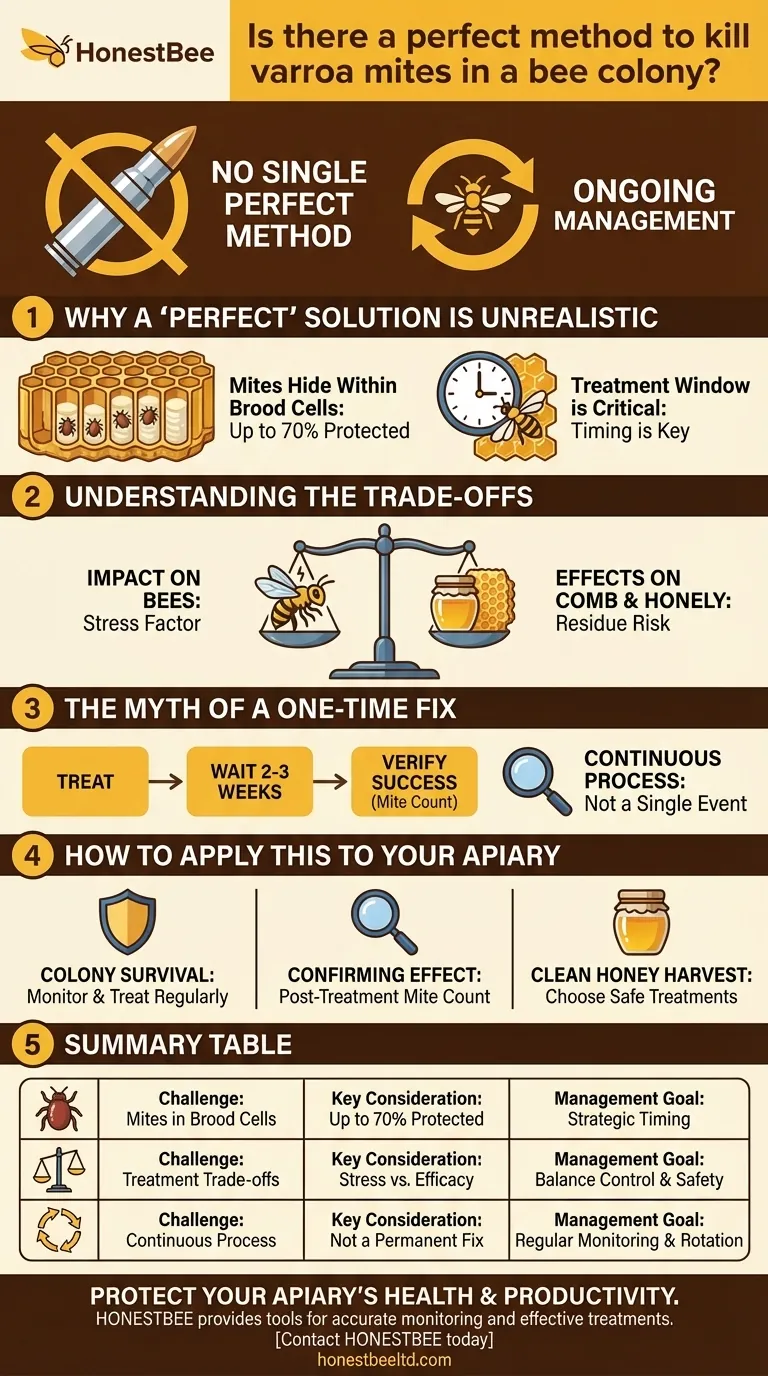To be direct, there is no single perfect method to kill all varroa mites in a bee colony. The challenge lies in the mite's life cycle, which is deeply integrated with the bees' own development. Because of this, every available treatment represents a calculated trade-off, aiming to control the mite population while minimizing harm to the bees, the comb, and the honey.
The core principle of varroa control is not eradication, but ongoing management. Success is measured by keeping mite levels low enough for the colony to thrive, which requires a strategic approach rather than a single solution.

Why a "Perfect" Solution is Unrealistic
The primary obstacle to a single, perfect treatment is the varroa mite's biology. They are not a simple external pest; they are deeply embedded within the colony's life cycle.
Mites Hide Within Brood Cells
A significant portion of the varroa mite population is not on adult bees. At any given time, up to 70% of a colony's mites can be hidden and reproducing inside sealed brood cells.
This protected environment makes them impervious to many treatments that only affect mites on adult bees (known as "phoretic" mites). A treatment might seem effective on the surface but can leave the majority of the mite population untouched.
The Treatment Window is Critical
Because mites are protected within the brood, the timing of any treatment is crucial. An approach that works when a colony has a large amount of brood may be ineffective or require a different strategy when the colony is broodless.
Understanding the Inevitable Trade-offs
Every method of varroa control comes with potential downsides. Acknowledging these trade-offs is the first step toward making an informed management decision.
Impact on the Bees
No treatment is completely benign. All methods, whether chemical or organic, introduce a stressor into the colony. The goal is to choose a treatment where the negative impact on the mites far outweighs the stress placed on the bees.
Effects on Comb and Honey
Some treatments can leave residues in the wax comb or honey. This is a critical consideration, especially for beekeepers who plan to harvest honey for consumption. Choosing the right treatment often involves balancing mite control with the preservation of hive products.
The Myth of a One-Time Fix
Effective varroa management is a continuous process, not a single event. A single treatment, no matter how effective, will not solve the problem permanently.
Verifying Treatment Success
It is essential to perform a follow-up mite check a few weeks after any treatment. This is not a sign of a failed treatment but a necessary step to confirm its efficacy.
This verification tells you if the mite population was successfully reduced to a manageable level and informs your strategy for the coming months.
How to Apply This to Your Apiary
Your approach should shift from seeking a silver bullet to implementing a multi-faceted management plan. Your immediate goal will determine your next step.
- If your primary focus is colony survival: Your priority is to accurately monitor mite levels and treat when thresholds are crossed, regardless of the season.
- If your primary focus is confirming a treatment's effect: Conduct a mite count two to three weeks after application to ensure the population has dropped significantly.
- If your primary focus is a clean honey harvest: Select treatments that are approved for use during a honey flow and have minimal impact on the final product.
Effective varroa control is achieved not through a single perfect weapon, but through a persistent and strategic management plan.
Summary Table:
| Challenge | Key Consideration | Management Goal |
|---|---|---|
| Mites in Brood Cells | Up to 70% of mites are protected inside cells. | Use treatments effective on phoretic mites and time applications strategically. |
| Treatment Trade-offs | All methods stress bees; some affect honey/comb. | Balance mite control efficacy with hive product safety. |
| Continuous Process | A single treatment is not a permanent solution. | Implement regular monitoring and a rotation of approved treatments. |
Protect Your Apiary's Health and Productivity
Strategic varroa mite management is the cornerstone of successful beekeeping. As a commercial apiary or beekeeping equipment distributor, your operation's viability depends on healthy colonies. HONESTBEE supplies the wholesale beekeeping supplies and equipment you need to implement an effective, continuous management plan.
We provide the tools for accurate monitoring and a range of approved treatments to help you control mite populations, protect your honey harvest, and ensure your colonies thrive.
Contact HONESTBEE today to discuss your specific needs and build a resilient, productive apiary.
Visual Guide

Related Products
- Adjustable Formic and Acetic Acid Dispenser for Bee Mite Treatment
- Varroa Easy Check Mite Tester Kit Counter Alcohol Wash Jar
- Economy Galvanized Beekeeping Honey Bee Smoker for Wholesale
- Professional Bee Smoker with Elongated Spout and Durable Bellows for Beekeeping
- Professional Insulated Winter Hive Wrap for Beekeeping
People Also Ask
- What should beekeepers do to manage varroa mites effectively? Adopt a Proactive Monitoring Strategy
- What are the symptoms of Varroa Mite Syndrome (VMS)? Recognizing the Signs of Colony Collapse
- How can beekeepers ensure their hives survive the winter? A Guide to Colony Survival
- What is the focus of hive management during summer? Maximize Your Honey Harvest with Expert Tips
- What are phoretic mites? A Beekeeper's Guide to Monitoring Varroa Infestation



















